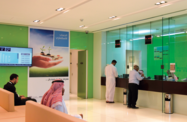Saudi Arabia’s insurance industry is making impressive strides, with policy take-up growing, premiums increasing, and the sector’s regulatory body strengthening. However, penetration rates still have a considerable way to go if they are to reach those of developed markets.
The insurance sector is playing an increasingly significant role in Saudi Arabia’s economy, with far greater funds at its disposal as more businesses and individuals recognise the importance of having coverage. Data issued earlier this year by the Saudi Arabian Monetary Agency (SAMA), the regulator of the Kingdom’s financial services sector, including the insurance industry, estimated the total value of premiums written in 2010 rose by 12.4% over the previous year’s performance – a rise from $3.9bn to $4.3bn. This strong growth helped push the insurance sector’s contribution to GDP to the equivalent of 1%, according to SAMA.
Last year was also good for the industry regarding payouts. SAMA estimated claims processed came to $1.25bn, down from $1.54bn in 2009, which allowed some firms to build up reserves.
While the 2010 results were positive and indicate the industry is gaining strength, SAMA’s vice-governor, Abdulrahman Al Hamidy, flagged extensive reforms for the sector in a speech earlier this year. Though he noted much progress had been made in improving services and results, as well as boosting compliance with laws and regulations, Al Hamidy said more must be done to modernise the industry.
A major step towards fulfilling the vice-governor’s goals was unveiled at the end of July, when SAMA issued a draft of its audit committee regulations for insurance and reinsurance companies. Among key reforms in the new regulation is the creation of audit committees by all insurers and reinsurers operating in Saudi Arabia. Firms must also establish appropriate written controls and procedures to ensure and monitor compliance with mandatory requirements.
The newly established audit committees will be required to submit reports and recommendations directly to SAMA, and companies must maintain adequate records to demonstrate regulation compliance. Each committee must also have a degree of independence, with three of its five members required to come from outside of the company’s board. Members also cannot be appointed from among the company’s executive managers, employees or consultants.
SAMA’s new regulation – which the industry can comment on until late September – is intended to strengthen transparency and accountability within the insurance sector and to put it on a more solid footing to build on recent successes.
The impressive rate of growth seen in 2010 looks poised to continue, with Saudi Arabia’s insurance sector believed to be one of the regional industry’s prime movers. A report released in late August by Dubai-based investment bank Alpen Capital said premium growth across the GCC region would increase by some 20% a year between 2011 and 2015, lifting total premium values from the current $18bn to $37bn. Of that total, 75% would be concentrated in Saudi Arabia and the UAE.
The report also found the Kingdom’s insurance profile will diverge from other GCC member states, with a much stronger anticipated uptake in life insurance policies. The life insurance sector is expected to have a compounded annual growth rate (CAGR) of 48%, while the non-life sector will grow at a steadier CAGR of 14%, according to Alpen. Overall, the Saudi insurance sector is forecasted to expand by a CAGR of 18% by the middle of the decade, reaching a total value of $9.23bn.
According to Sameena Ahmad, the managing director at Alpen Capital, there are several factors helping power growth, including wider adoption of new distribution models such as cooperation with banks. “The industry’s growth is also aided by government spending, diversification of the economy and the emergence of sharia-compliant products,” Ahmad said.
Another factor with strong potential to lift the insurance sector’s value is the sharp increase forecasted for the country’s construction industry, a result of the government’s massive infrastructure investment programme over the next decade. With billions being ploughed into transport, housing, health and education developments, a raft of insurance opportunities will arise since the hundreds of projects will need comprehensive coverage.
While premiums and penetration rates are rising, Saudi Arabia’s insurance sector still has a long way to go before matching levels in many Western countries. The Kingdom’s insurance sector is now valued at 1% of GDP, whereas the ratio of premiums to domestic product is well over 10% in France and around 13% in the UK.
This will change in time, as more Saudis come to see the value of having private coverage and the sector grows in sophistication. While the state provides extensive health care and pensions, a growing number of Saudis will look to supplement benefits on offer by taking out policies with local insurers. By increasing options on offer, the insurance industry should meet the optimistic growth targets forecasted for it.

